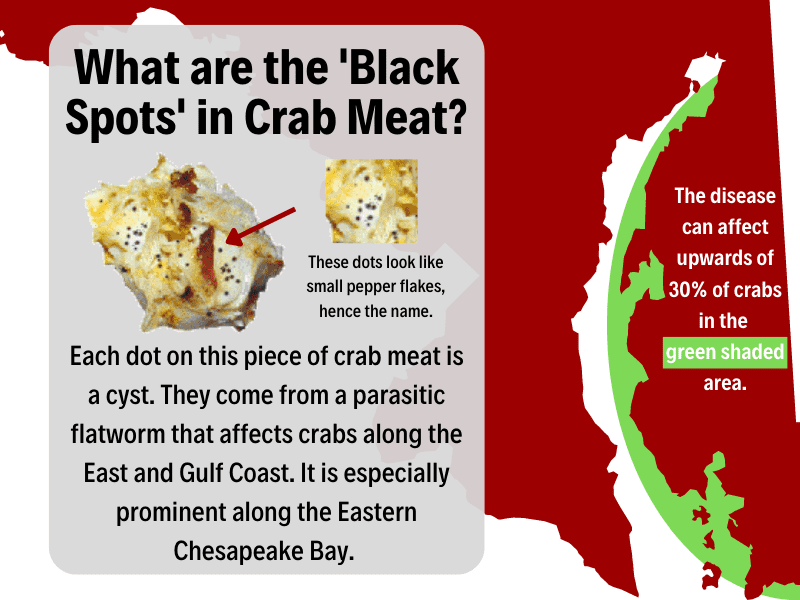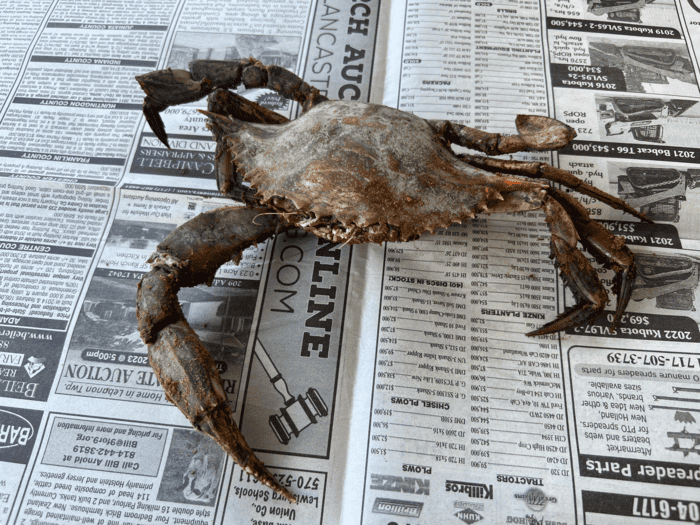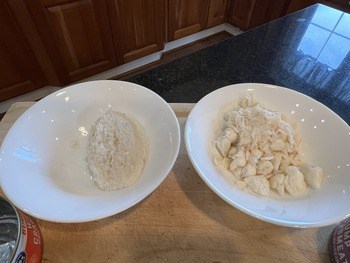What Do Black Spots on Crab Meat Mean? (Is it safe to eat?)
Have you ever been at a crab feast and noticed that your crab meat has black spots on it? It almost looks like someone sprinkled some black pepper on it. Well, I’m here to tell you that this is not black pepper, but something else.
Small, black spots on cooked crab meat is a result of an aquatic parasitic flatworm, Microphallus bassodactylus, that infects blue crabs along the East Coast and Gulf of Mexico. The parasite is destroyed when the crab is cooked making it safe to eat, but unappealing to look at.
Let’s go into more information on what this parasite is and how to make sure it’s safe to eat.
What you should know about the “Pepper Spot” Disease
To understand why your crab meat looks like this, I want to explain it in laymans terms without all the science mumbo jumbo. Personally, I don’t retain anything unless its explained like I’m a 5-year-old.
So, parasites are found in the same water where we catch blue crabs. From Maine to Texas, there is a parasite that is spread to blue crabs via sea snails and other bottom feeders. It takes the shape of a small worm. Once the worm infects a blue crab, it is slowly eaten away and leaves a small cyst behind, which is the black dot you see in your crab meat.
These black dots look like someone shook a black pepper shaker on your crab meat, which has given it the name of “Pepper Spot” Disease.
Scientists found this disease more often in water with a higher sailinity, or higher salt content. This water is usually closer to the ocean, but spreads North during the hotter months of the summer.
This disease is very common to the Chesapeake Bay Eastern Shore and affects over 30% of blue crabs in some areas. See The Virginia Institute of Marine Science for more information.

How to know for sure infected meat is safe to eat
I don’t know about you, but the idea of eating a parasite isn’t appealing to me. However, it’s shown that the parasite is destroyed when the crab is cooked.
“Black Pepper” disease affects the athestetic of crab meat, but it’s cooked out of the crab when its boiled of steamed for at least 10 minutes. Like any crab, the meat should be cooked through and the shell of the crab should be orange-red.
All that is left behind is the black dots in the crab meat. These are permanant cysts in the crab meat and does not affect the taste or quality of the meat. The parasite has been cooked away, and the meat is completely safe to eat.
Whether you want to eat the meat with that information is up to you. There is no shame in picking a new crab without any blemishes. It’s important that you feel good about what you’re eating at a crab feast, and anywhere for that matter.
Signs the infected meat is unsafe to eat
While “Black Pepper” Disease does not make the meat unsafe to eat, crabs dying long before being cooked can. This will lead to a number of signs including a change in taste, smell, and texture. Here are a few things to look out for when eating crabs that make it unsafe to eat. This applies to all meat, whether it’s littered with black dots or not.
The crab smells like ammonia.
A dead giveaway that your crab is unsafe to eat is if it gives off a foul smell or reeks of ammonia. Regardless of how your crab meat looks, the smell of ammonia is a byproduct of decomposing crab meat.
Crabs are bottom feeders which causes them to house lots of bacteria and pathogens, which is why their meat will decay very shortly after they perish. Parasites such as those that cause the “black pepper” disease quickly rot away its meat. Do not eat any crabs that smell like ammonia.
I go over this whole topic in my article: Crabs Smell Like Ammonia: What Should You Do?.
The crab’s meat is discolored.
If you cut open your crab and see that it is green or dark gray, it may have died before being cooked. This color is usually accompanied by a poor meat texture or an ammonia smell.
I understand I explained that black pepper spots are safe in your crab, but completely different-color crabs should be approached with caution.
If you are uncomfortable with the way your crab meat looks, do not be afraid to throw it away and get a new one. It’s important to be comfortable with what you are eating, and better to be safe than sorry.
The crab’s meat has a poor taste and texture.
You’ll know it when you taste it. If you take a bite into your crab and the meat’s texture is off-putting or the taste feels bland, the crab may have died before being cooked. Crab meat should have a soft texture and not be chewy. It should also taste fresh and almost sweet.
If there is no accompanying ammonia smell or discoloring of the meat, there is a good chance that it did not die a long time before being cooked. However, I do not advise eating any crab that tastes off. Throw it away and get a new crab.




